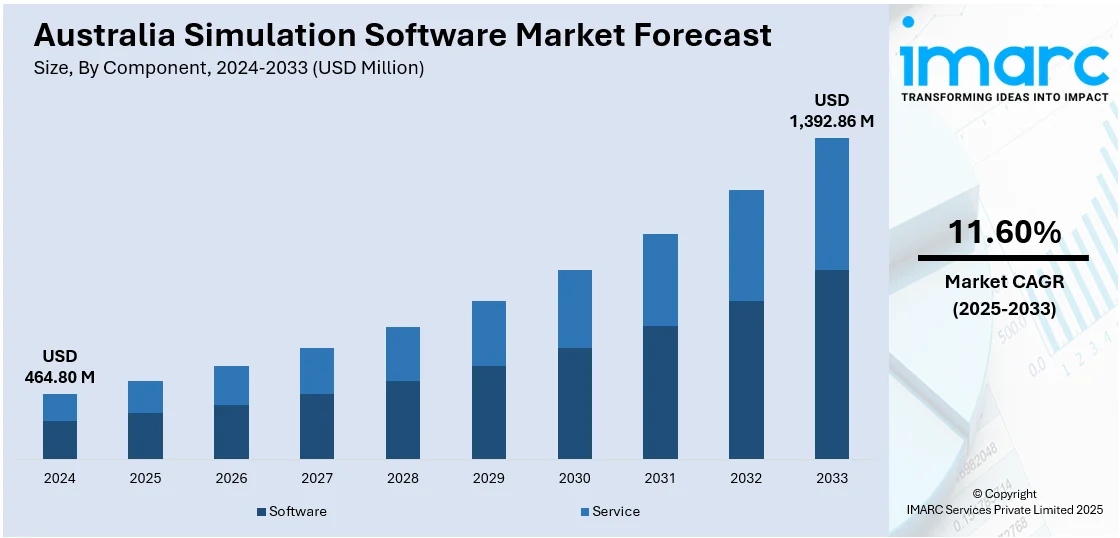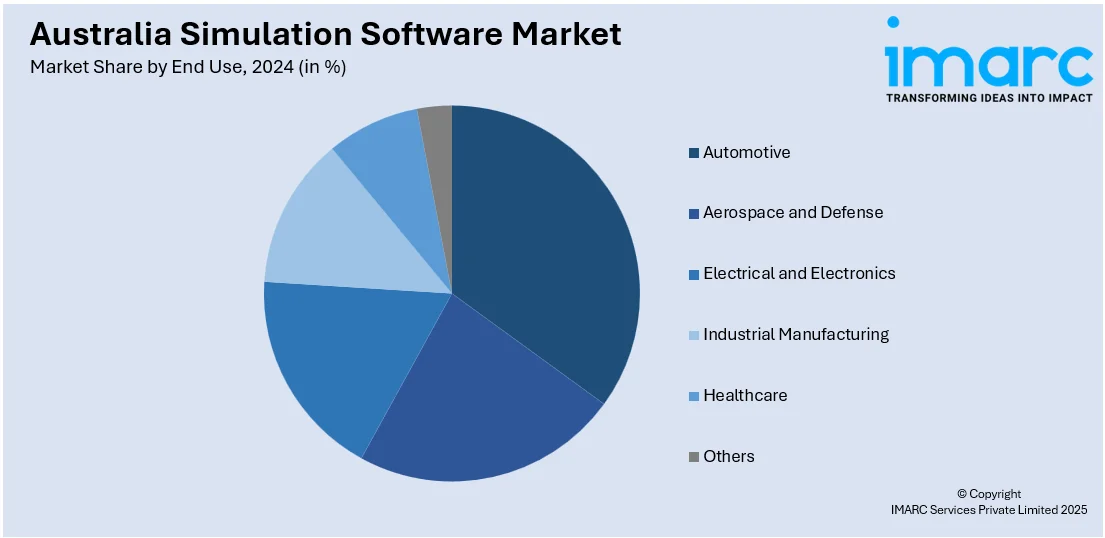
Australia Simulation Software Market Size, Share, Trends and Forecast by Component, Deployment, End Use, and Region, 2025-2033
Australia Simulation Software Market Overview:
The Australia Simulation Software Market size reached USD 464.80 Million in 2024. Looking forward, IMARC Group expects the market to reach USD 1,392.86 Million by 2033, exhibiting a growth rate (CAGR) of 11.60% during 2025-2033. The market is fueled by technology advancements, such as artificial intelligence (AI), machine learning (ML), and cloud computing. Growing demand for efficient product design, real-time data analysis, and affordable solutions also drives growth. Aerospace, manufacturing, and healthcare industries demand simulations to improve operations and facilitate innovation is driving the Australia simulation software market share.
|
Report Attribute
|
Key Statistics
|
|---|---|
|
Base Year
|
2024
|
|
Forecast Years
|
2025-2033
|
|
Historical Years
|
2019-2024
|
| Market Size in 2024 | USD 464.80 Million |
| Market Forecast in 2033 | USD 1,392.86 Million |
| Market Growth Rate 2025-2033 | 11.60% |
Australia Simulation Software Market Trends:
Integration of Artificial Intelligence and Machine Learning
As of June 30, 2024, 56 Australian Government entities have adopted AI, a significant increase from 27 the previous year. These organizations use AI mainly in research and development (R&D), information technology (IT) systems management, and reporting of data. Those agencies have also implemented internal policies to promote ethical and responsible use of AI, with 64% of them doing so. This rising usage is part of major trend in the Australian simulation software market, where AI and ML are improving simulation capabilities across aerospace, automotive, and healthcare industries. Through improved decision-making and real-time data processing, AI and ML are making simulations more intelligent and flexible. AI and ML enhance product design, minimize trial-and-error, and enable organizations to save time and money. Growing AI integration within simulation software is transforming the way Australian businesses engage in product testing, forecasting, and system performance.

To get more information on this market, Request Sample
Adoption of Cloud-Based Simulation Platforms
In Australia, cloud-based simulation software is becoming more popular as businesses abandon traditional on-site solutions. As cloud platforms are adaptable, scalable, and cost-effective, businesses may run high-performance simulations without having to invest heavily in infrastructure. This trend is highly advantageous for small and medium-scale businesses (SMEs), which can also be utilized for highly developed simulation tools without huge initial investments. The cloud also makes it simple to collaborate, receive updates more quickly, and access simulation results more easily from anywhere. With cloud-based platforms, Australian companies can simplify their development processes and remain competitive in an increasingly digital marketplace.
Rise of Digital Twins for Real-Time Monitoring
The application of digital twins virtual replicas of physical systems is increasingly underway in Australia, and is mainly being pursued in manufacturing, infrastructure, and smart cities. Digital twins allow real-time monitoring to be done, enabling companies to monitor the performance of physical assets remotely. Organizations can anticipate possible problems, schedule maintenance, and improve performance by simulating actual operations, thus resulting in increased efficiency and cost savings. Western Australia's government has, for instance, put AUD 140 million into spatial digital twin projects to enhance urban planning and infrastructure management. With more industries in Australia embracing Internet of Things (IoT) solutions, digital twins are proving crucial to advance decision-making and control operations. This increasing fusion is assisting enterprises to sustain and optimize their infrastructure, minimize downtime, and enable efficiencies, placing digital twins further contributing to the Australia simulation software market growth.
Australia Simulation Software Market Segmentation:
IMARC Group provides an analysis of the key trends in each segment of the market, along with forecasts at the country and regional levels for 2025-2033. Our report has categorized the market based on component, deployment, and end use.
Component Insights:
- Software
- Service
The report has provided a detailed breakup and analysis of the market based on the component. This includes software and service.
Deployment Insights:
- On-premises
- Cloud-based
A detailed breakup and analysis of the market based on the deployment have also been provided in the report. This includes on-premises, and cloud-based.
End Use Insights:

- Automotive
- Aerospace and Defense
- Electrical and Electronics
- Industrial Manufacturing
- Healthcare
- Others
The report has provided a detailed breakup and analysis of the market based on the end use. This includes automotive, aerospace and defense, electrical and electronics, industrial manufacturing, healthcare, and others.
Regional Insights:
- Australia Capital Territory & New South Wales
- Victoria & Tasmania
- Queensland
- Northern Territory & Southern Australia
- Western Australia
The report has also provided a comprehensive analysis of all the major regional markets, which include Australia Capital Territory & New South Wales, Victoria & Tasmania, Queensland, Northern Territory & Southern Australia, and Western Australia.
Competitive Landscape:
The market research report has also provided a comprehensive analysis of the competitive landscape. Competitive analysis such as market structure, key player positioning, top winning strategies, competitive dashboard, and company evaluation quadrant has been covered in the report. Also, detailed profiles of all major companies have been provided.
Australia Simulation Software Market News:
- In February 2025, Australian companies Aspen Medical and BlueRoom Simulations teamed up to introduce mixed reality (MR) technology for military healthcare training. The platform focuses on medic and first responder skills, offering realistic training scenarios such as intravenous cannulation and airway management in high-risk environments. The MR Simulation eliminates handheld controllers, allowing users to interact naturally. This collaboration aims to enhance medical training efficiency, reduce costs, and maintain operational readiness in military settings.
- In September 2024, The Australian Defence Force (ADF) renewed its agreement with Bohemia Interactive Australia (BIA) for the twelfth consecutive year, continuing to use VBS3 for virtual simulation and training. The software enhances operational preparedness through immersive gaming experiences. The agreement also covers support for BISim's Image Generator software across the ADF's Weapon Training Simulation Systems. BIA’s VBS4 and TerraTools are also gaining traction in Australia, New Zealand, and among AUKUS partners.
Australia Simulation Software Market Report Coverage:
| Report Features | Details |
|---|---|
| Base Year of the Analysis | 2024 |
| Historical Period | 2019-2024 |
| Forecast Period | 2025-2033 |
| Units | Million USD |
| Scope of the Report |
Exploration of Historical Trends and Market Outlook, Industry Catalysts and Challenges, Segment-Wise Historical and Future Market Assessment:
|
| Components Covered | Software, Service |
| Deployments Covered | On-premises, Cloud-based |
| End Uses Covered | Automotive, Aerospace and Defense, Electrical and Electronics, Industrial Manufacturing, Healthcare, Others |
| Regions Covered | Australia Capital Territory & New South Wales, Victoria & Tasmania, Queensland, Northern Territory & Southern Australia, Western Australia |
| Customization Scope | 10% Free Customization |
| Post-Sale Analyst Support | 10-12 Weeks |
| Delivery Format | PDF and Excel through Email (We can also provide the editable version of the report in PPT/Word format on special request) |
Key Questions Answered in This Report:
- How has the Australia simulation software market performed so far and how will it perform in the coming years?
- What is the breakup of the Australia simulation software market on the basis of component?
- What is the breakup of the Australia simulation software market on the basis of deployment?
- What is the breakup of the Australia simulation software market on the basis of end use?
- What is the breakup of the Australia simulation software market on the basis of region?
- What are the various stages in the value chain of the Australia simulation software market?
- What are the key driving factors and challenges in the Australia simulation software market?
- What is the structure of the Australia simulation software market and who are the key players?
- What is the degree of competition in the Australia simulation software market?
Key Benefits for Stakeholders:
- IMARC’s industry report offers a comprehensive quantitative analysis of various market segments, historical and current market trends, market forecasts, and dynamics of the Australia simulation software market from 2019-2033.
- The research report provides the latest information on the market drivers, challenges, and opportunities in the Australia simulation software market.
- Porter's five forces analysis assist stakeholders in assessing the impact of new entrants, competitive rivalry, supplier power, buyer power, and the threat of substitution. It helps stakeholders to analyze the level of competition within the Australia simulation software industry and its attractiveness.
- Competitive landscape allows stakeholders to understand their competitive environment and provides an insight into the current positions of key players in the market.
Need more help?
- Speak to our experienced analysts for insights on the current market scenarios.
- Include additional segments and countries to customize the report as per your requirement.
- Gain an unparalleled competitive advantage in your domain by understanding how to utilize the report and positively impacting your operations and revenue.
- For further assistance, please connect with our analysts.
 Request Customization
Request Customization
 Speak to an Analyst
Speak to an Analyst
 Request Brochure
Request Brochure
 Inquire Before Buying
Inquire Before Buying




.webp)




.webp)












